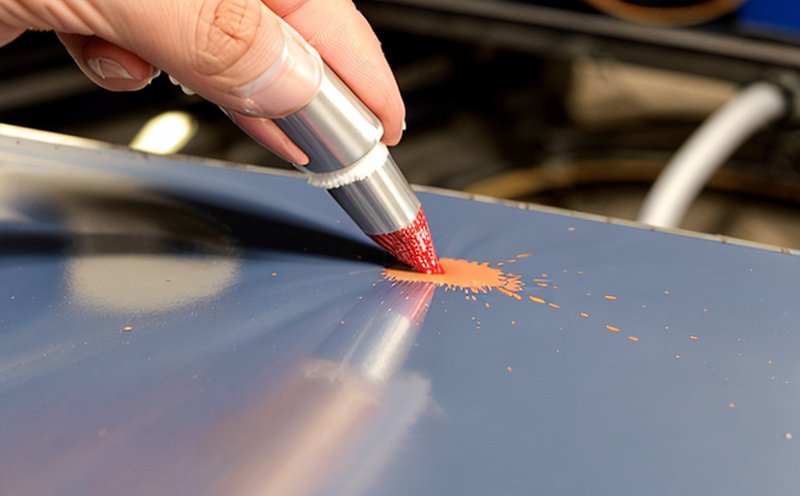ISO 2812-2 Resistance of Laminates to Liquid Chemicals Testing
The ISO 2812 series specifically addresses testing methods and criteria for the resistance of laminates to liquid chemicals. This section focuses on ISO 2812-2, which specifies a method for determining the resistance of laminates to immersion in various chemical liquids under specified conditions.
Laminates are composite materials used extensively in furniture manufacturing, offering aesthetic appeal and structural strength. The integrity of these laminates is crucial for ensuring that products meet durability and safety standards. ISO 2812-2 provides a standardized method to evaluate the laminate's resistance against chemical exposure, which can occur during normal use or accidental spills.
The test involves submerging specimens in different chemical solutions for predetermined durations under controlled conditions. The primary objective is to assess whether the laminate undergoes significant degradation such as swelling, discoloration, loss of adhesion, or other visible signs that could compromise its performance and appearance over time.
This testing procedure ensures that furniture manufacturers can confidently select materials that will withstand chemical exposure without compromising their product quality. Compliance with this standard is particularly important for industries where products come into contact with chemicals, such as healthcare facilities, laboratories, and areas prone to spills or stains.
The process begins by selecting appropriate test solutions based on the expected environmental conditions. For instance, common solvents like water, alcohol, detergents, or industrial cleaning agents might be used in accordance with specific application needs. Specimens are then prepared according to ISO guidelines, ensuring that they accurately represent real-world scenarios.
The testing apparatus typically includes a container for holding the chemical solutions and a means of measuring temperature and time accurately. Specimens are immersed in these solutions under specified conditions for designated periods before being examined visually or through more precise analytical methods. Visual inspection is often sufficient to identify significant changes; however, quantitative measurements may also be taken depending on the requirements.
The acceptance criteria involve comparing post-test specimens against pre-test ones to determine if there has been any unacceptable change in appearance or performance characteristics. Any notable differences would indicate insufficient resistance to chemical exposure, necessitating reevaluation of material selection or process improvements.
Understanding how different chemicals interact with laminates helps furniture makers design products that not only meet aesthetic expectations but also perform reliably under various environmental stressors. By adhering to ISO 2812-2 guidelines, manufacturers can enhance product longevity and safety while maintaining regulatory compliance.
Scope and Methodology
The scope of ISO 2812-2 encompasses the determination of resistance of laminates to immersion in liquid chemicals. This testing method applies primarily to solid materials used as surfaces on furniture items where there is potential for direct contact with various types of liquids.
- Chemical solutions tested include water, alcohols, detergents, solvents, and other relevant substances.
- The procedure involves submerging specimens in these solutions under controlled conditions to assess their integrity after exposure.
- Visual inspection combined with optional quantitative measurements is used to evaluate changes in appearance or performance characteristics post-exposure.
The methodology outlined in ISO 2812-2 provides clear instructions for preparing test samples, selecting appropriate chemicals, setting up the testing environment, and interpreting results. Compliance ensures that manufacturers produce robust furniture components capable of enduring expected chemical exposures without degradation.
Industry Applications
ISO 2812-2 resistance testing is vital for various sectors within the furniture industry, particularly those dealing with high-risk environments or frequent contact with chemicals. Healthcare facilities, laboratories, and educational institutions often require furniture materials that can withstand harsh chemical conditions without compromising their functionality.
In healthcare settings, durable furniture must resist spillage from medical equipment or patient care products containing corrosive substances. Similarly, in educational institutions, where students may handle diverse chemicals during laboratory activities, sturdy work surfaces are essential to maintain safety standards.
For retail establishments dealing with food and beverage products, choosing laminates resistant to common cleaning agents ensures longevity while preventing contamination risks. Additionally, industrial settings benefit from furniture materials that can endure frequent chemical wash-downs without damage.
The resistance of laminates tested according to ISO 2812-2 not only contributes to improved product performance but also supports compliance with international safety regulations and industry best practices. By incorporating this testing into their quality assurance protocols, manufacturers can enhance customer satisfaction and trust in their products.
Use Cases and Application Examples
- Healthcare Facilities: Ensuring that furniture used in patient rooms and treatment areas remains free from harmful chemical residues after cleaning.
- Laboratories: Providing durable work surfaces capable of withstanding frequent exposure to laboratory chemicals during experiments and research activities.
- Educational Institutions: Selecting sturdy furniture items that can endure regular use in chemistry labs without sustaining damage from spilled reagents or cleaning agents.
- Retail Establishments: Guaranteeing the longevity of food preparation counters exposed to various detergents and disinfectants during daily operations.
- Industrial Settings: Choosing furniture components that can withstand harsh chemical environments in manufacturing plants where continuous cleaning processes are necessary.
These examples illustrate how ISO 2812-2 plays a crucial role in ensuring the reliability and safety of furniture across different industries. By implementing this testing method, manufacturers can improve product quality while also meeting regulatory requirements.





